Which Part Of The Cell Controls Movement In And Out Of The Nucleus
Learning Objectives
- Depict the structure and office of the nucleus
- Explain the system of DNA inside the nucleus
- Describe the construction and function of the major cellular organelles
- The Nucleus and Its DNA
- Organelles of the Endomembrane System
- Endoplasmic Reticulum
- The Golgi Apparatus
- Lysosomes
- Organelles for Energy Production and Detoxification
- Mitochondria
- Peroxisomes
- The Cytoskeleton
At present that you have learned that the plasma membrane surrounds all cells, you can dive within of a prototypical human being cell to acquire most its internal components and their functions. Animal cells incorporate three main regions: plasma membrane, nucleus, and cytoplasm. The nucleus is a cell'southward central organelle, which contains the cell'south Deoxyribonucleic acid (Figure three.6). The cytoplasm is composed of two parts, the cytosol and organelles. Cytosol , the jelly-similar substance inside the prison cell, provides the fluid medium necessary for biochemical reactions. An organelle ("lilliputian organ") is i of several different types of membrane-enclosed bodies in the prison cell, each performing a unique part. Just as the various bodily organs work together in harmony to perform all of a man's functions, the many different cellular organelles work together to proceed the cell healthy and performing all of its important functions.

The Nucleus
The nucleus is the largest and most prominent of a cell's organelles (Figure 3.7). The nucleus is mostly considered the control heart of the cell because it stores all of the genetic instructions for manufacturing proteins. Interestingly, some cells in the body, such as muscle cells, comprise more than one nucleus, which is known as multinucleated. Other cells, such as mammalian cherry blood cells (RBCs), do not contain nuclei at all. RBCs eject their nuclei as they mature, making space for the large numbers of hemoglobin molecules that bear oxygen throughout the trunk. Without nuclei, the life span of RBCs is short, and and so the torso must produce new ones constantly.
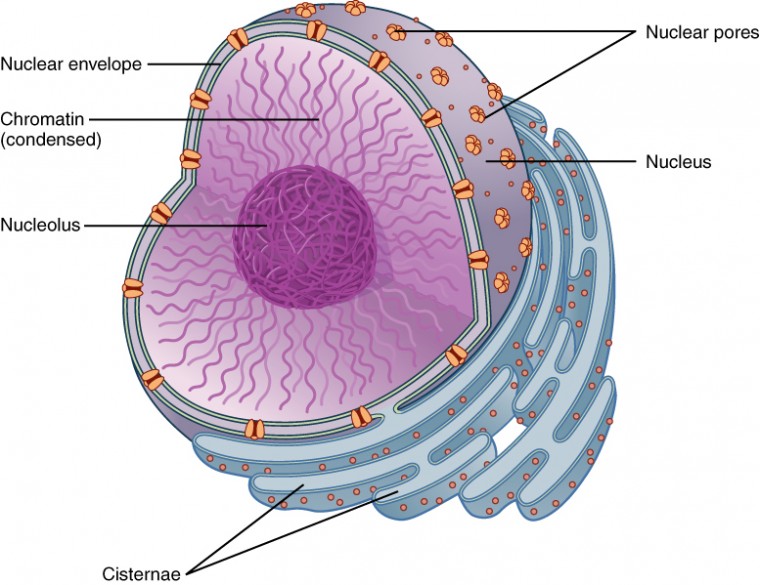
Within the nucleus lies the design that dictates everything a jail cell will practise and all of the products it will make. This data is stored within Deoxyribonucleic acid. The nucleus sends "commands" to the cell via molecular messengers that translate the information from Dna. Each cell in your body (with the exception of germ cells) contains the complete fix of your Deoxyribonucleic acid. When a cell divides, the Deoxyribonucleic acid must be duplicated so that the each new cell receives a full complement of DNA. The following section will explore the structure of the nucleus and its contents, equally well as the process of Deoxyribonucleic acid replication.
Organization of the Nucleus and Its DNA
Similar most other cellular organelles, the nucleus is surrounded past a membrane called the nuclear envelope . This membranous roofing consists of 2 adjacent lipid bilayers with a thin fluid infinite in between them. Spanning these two bilayers are nuclear pores. A nuclear pore is a tiny passageway for the passage of proteins, RNA, and solutes between the nucleus and the cytoplasm. Within the nuclear envelope is a gel-like nucleoplasm with solutes that include the building blocks of nucleic acids. In that location also can exist a night-staining mass oftentimes visible under a simple light microscope, called a nucleolus (plural = nucleoli). The nucleolus is a region of the nucleus that is responsible for manufacturing the RNA necessary for structure of ribosomes. Once synthesized, newly made ribosomal subunits exit the jail cell's nucleus through the nuclear pores. The genetic instructions that are used to build and maintain an organism are arranged in an orderly manner in strands of Deoxyribonucleic acid. Inside the nucleus are threads of chromatin equanimous of Dna and associated proteins (Figure three.8). Chromatin is a stringy, fibrous form of DNA that allows efficient packaging of DNA within the nucleus while maintaining a construction that allows early stages of proteins synthesis. Along the chromatin threads, the DNA is wrapped around a set ofhistone proteins. When a jail cell is in the process of partitioning, the chromatin condenses into chromosomes, so that the DNA can be safely transported to the "daughter cells." Thechromosome is composed of DNA and proteins; information technology is the condensed form of chromatin. It is estimated that humans accept almost 22,000 genes distributed on 46 chromosomes.
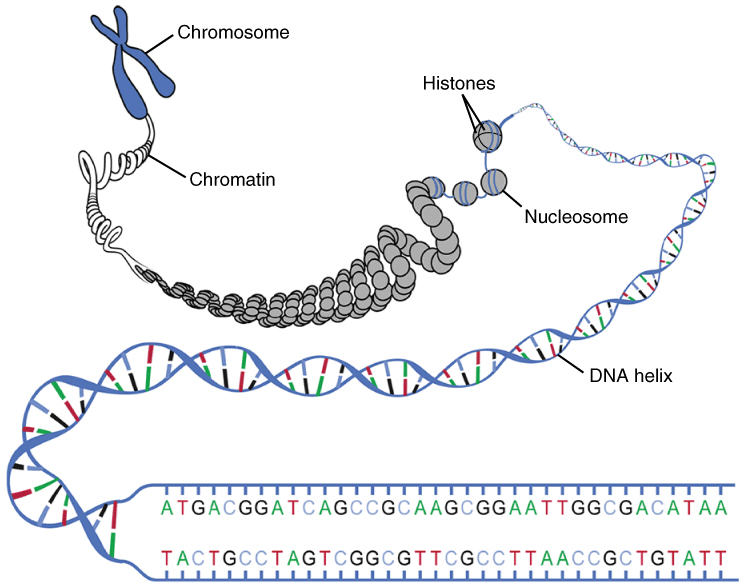
Organelles of the Endomembrane System
A fix of three major organelles together class a organization inside the cell called the endomembrane arrangement. These organelles piece of work together to perform diverse cellular jobs, including the task of producing, packaging, and exporting certain cellular products. The organelles of the endomembrane system include the endoplasmic reticulum, Golgi apparatus, and vesicles.
Endoplasmic Reticulum
The endoplasmic reticulum (ER) is a system of channels that is continuous with the nuclear membrane (or "envelope") covering the nucleus and composed of the same lipid bilayer material. The ER tin can be thought of as a series of winding thoroughfares similar to the waterway canals in Venice. The ER provides passages throughout much of the cell that function in transporting, synthesizing, and storing materials. The winding structure of the ER results in a large membranous area that supports its many functions (Figure 3.9).

Endoplasmic reticulum can be in two forms: crude ER and shine ER. These two types of ER perform some very different functions and tin be found in very different amounts depending on the type of jail cell. Rough ER (RER) is so-called considering its membrane is dotted with embedded granules—organelles called ribosomes, giving the RER a bumpy appearance.
A ribosome is an organelle that serves as the site of protein synthesis. Information technology tin can be plant free floating in the cytoplasm or attached to the ER. Information technology is composed of two ribosomal RNA subunits that wrap around mRNA to start the process of translation, a stage of poly peptide synthesis. Protein synthesis consists of 2 stages: transcription and translation. Transcription occurs within the nucleus and is a phase of proteins synthesis in which mRNA is copied from DNA. The mRNA leaves the nucleus via nuclear pores and goes to the ribosome. The ribosome then "reads" or interprets the instructions within mRNA and uses transfer RNA (tRNA) to link amino acids in the appropriate order to produce a protein (fig. 3.10). Typically, a protein is synthesized within the ribosome and released inside the channel of the crude ER, where sugars tin can be added to it (by a process called glycosylation) before it is transported within a vesicle to the next stage in the packaging and shipping procedure: the Golgi apparatus.
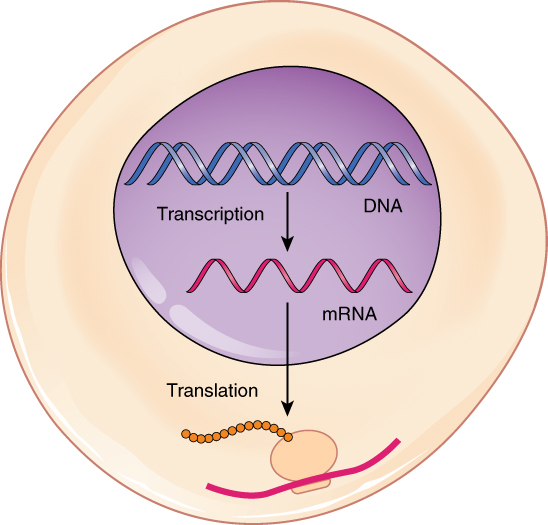
Smooth ER (SER) lacks these ribosomes. One of the main functions of the smoothen ER is in the synthesis of lipids. The smooth ER synthesizes phospholipids, the chief component of biological membranes, every bit well every bit steroid hormones. For this reason, cells that produce large quantities of such hormones, such as those of the female ovaries and male testes, comprise large amounts of smooth ER. In addition to lipid synthesis, the smooth ER also sequesters (i.e., stores) and regulates the concentration of calcium ions in muscle and nervous tissue. The shine ER additionally metabolizes some carbohydrates and performs a detoxification office in the liver, breaking downward certain toxins. In contrast with the smooth ER, the main job of the rough ER is the synthesis and modification of proteins destined for the cell membrane or for export from the cell. For this protein synthesis, many ribosomes adhere to the ER (giving it the studded appearance of rough ER).
The Golgi Apparatus
The Golgi apparatus is responsible for sorting, modifying, and aircraft off the products that come up from the rough ER, much like a post-function. The Golgi appliance looks like stacked flattened discs, about like stacks of oddly shaped pancakes. Like the ER, these discs are membranous. The Golgi apparatus has two distinct sides, each with a different role. One side of the apparatus receives products in vesicles. These products are sorted through the apparatus, and then they are released from the contrary side after being repackaged into new vesicles. If the product is to exist exported from the cell, the vesicle migrates to the cell surface and fuses to the cell membrane, and the cargo is secreted (Figure 3.11).
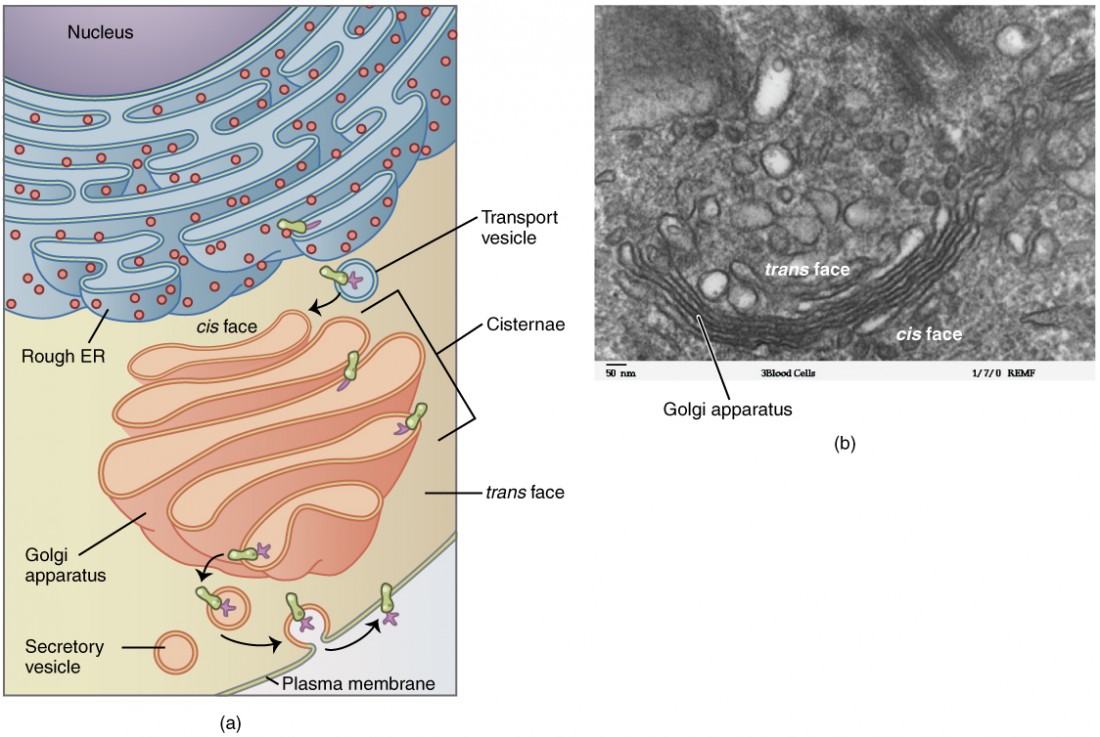
Lysosomes
Some of the protein products packaged by the Golgi include digestive enzymes that are meant to remain inside the cell for utilize in breaking downwards certain materials. The enzyme-containing vesicles released by the Golgi may form new lysosomes, or fuse with existing, lysosomes. A lysosome is an organelle that contains enzymes that suspension down and assimilate unneeded cellular components, such as a damaged organelle. (A lysosome is similar to a wrecking crew that takes downwardly old and unsound buildings in a neighborhood.)Autophagy ("self-eating") is the process of a cell digesting its own structures. Lysosomes are also important for breaking downwardly foreign material. For example, when certain immune defence cells (white claret cells) phagocytize bacteria, the bacterial cell is transported into a lysosome and digested by the enzymes inside. As one might imagine, such phagocytic defense cells comprise large numbers of lysosomes. Under certain circumstances, lysosomes perform a more than thou and dire part. In the case of damaged or unhealthy cells, lysosomes can exist triggered to open up upwardly and release their digestive enzymes into the cytoplasm of the cell, killing the cell. This "self-destruct" mechanism is chosenautolysis, and makes the process of prison cell decease controlled (a mechanism called "apoptosis").
Picket this video to learn about the endomembrane system, which includes the rough and shine ER and the Golgi torso as well as lysosomes and vesicles. What is the primary part of the endomembrane system?
Organelles for Energy Production and Detoxification
In addition to the jobs performed by the endomembrane system, the cell has many other important functions. Just as you must consume nutrients to provide yourself with energy, and then must each of your cells accept in nutrients, some of which convert to chemic energy that tin can be used to power biochemical reactions. Another important function of the cell is detoxification. Humans have in all sorts of toxins from the surround and also produce harmful chemicals as byproducts of cellular processes. Cells chosen hepatocytes in the liver detoxify many of these toxins.
Mitochondria
A mitochondrion (plural = mitochondria) is a bleary, bean-shaped organelle that is the "energy transformer" of the cell. Mitochondria consist of an outer lipid bilayer membrane likewise as an additional inner lipid bilayer membrane (Figure three.12). The inner membrane is highly folded into winding structures with a great deal of surface area, called cristae. Information technology is along this inner membrane that a serial of proteins, enzymes, and other molecules perform the biochemical reactions of cellular respiration. These reactions convert energy stored in nutrient molecules (such as glucose) into adenosine triphosphate (ATP), which provides usable cellular energy to the cell. Cells use ATP constantly, and so the mitochondria are constantly at piece of work. Oxygen molecules are required during cellular respiration, which is why you must constantly breathe it in. One of the organ systems in the trunk that uses huge amounts of ATP is the muscular system because ATP is required to sustain muscle contraction. As a result, muscle cells are packed total of mitochondria. Nervus cells also demand large quantities of ATP to run their sodium-potassium pumps. Therefore, an private neuron will be loaded with over a thousand mitochondria. On the other hand, a os jail cell, which is non nearly as metabolically-active, might only accept a couple hundred mitochondria.
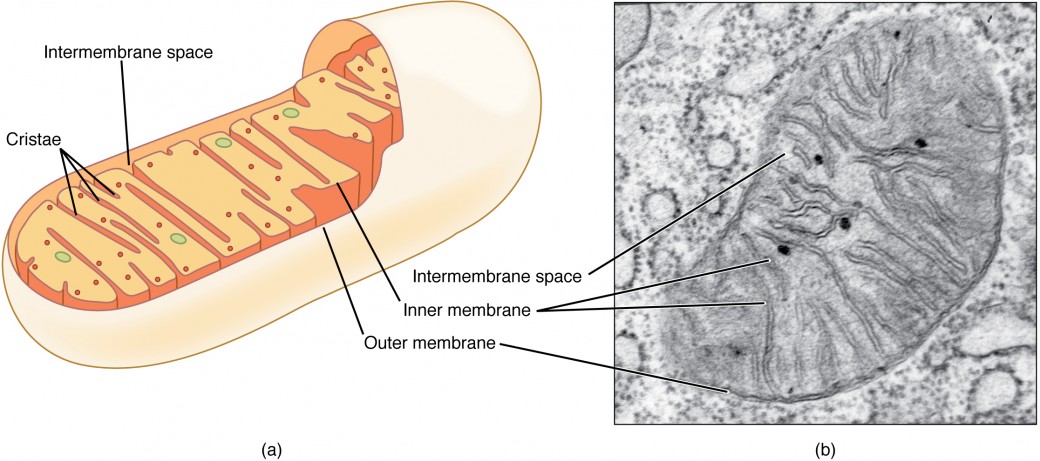
Peroxisomes
Like lysosomes, a peroxisome is a membrane-bound cellular organelle that contains generally enzymes (Figure 3.thirteen). Peroxisomes perform a couple of different functions, including lipid metabolism and chemical detoxification. In dissimilarity to the digestive enzymes found in lysosomes, the enzymes inside peroxisomes serve to transfer hydrogen atoms from various molecules to oxygen, producing hydrogen peroxide (HtwoO2). In this way, peroxisomes neutralize poisons such as booze. In gild to appreciate the importance of peroxisomes, it is necessary to understand the concept of reactive oxygen species.
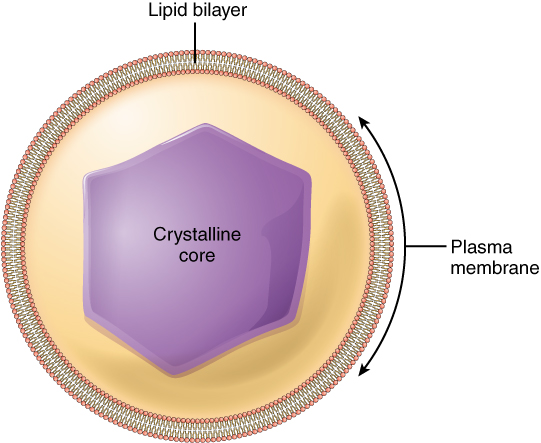
Reactive oxygen species (ROS) such equally peroxides and free radicals are the highly reactive products of many normal cellular processes, including the mitochondrial reactions that produce ATP and oxygen metabolism. Examples of ROS include the hydroxyl radical OH, H2O2, and superoxide ( O2 −). Some ROS are important for sure cellular functions, such as jail cell signaling processes and allowed responses confronting foreign substances. Costless radicals are reactive because they contain free unpaired electrons; they can easily oxidize other molecules throughout the prison cell, causing cellular damage and even cell death. Free radicals are thought to play a function in many subversive processes in the body, from cancer to coronary artery disease. Peroxisomes, on the other hand, oversee reactions that neutralize gratuitous radicals. Peroxisomes produce large amounts of the toxic HiiOtwo in the process, but peroxisomes contain enzymes that convert HtwoO2 into water and oxygen. These byproducts are safely released into the cytoplasm. Like miniature sewage treatment plants, peroxisomes neutralize harmful toxins then that they do non wreak havoc in the cells. The liver is the organ primarily responsible for detoxifying the blood before it travels throughout the trunk, and liver cells incorporate an exceptionally high number of peroxisomes. Defense mechanisms such as detoxification within the peroxisome and certain cellular antioxidants serve to neutralize many of these molecules. Some vitamins and other substances, found primarily in fruits and vegetables, have antioxidant properties. Antioxidants work past being oxidized themselves, halting the subversive reaction cascades initiated by the free radicals. Sometimes though, ROS accrue across the capacity of such defenses.Oxidative stress is the term used to describe damage to cellular components caused by ROS. Due to their characteristic unpaired electrons, ROS can fix off concatenation reactions where they remove electrons from other molecules, which so become oxidized and reactive, and practise the same to other molecules, causing a concatenation reaction. ROS can crusade permanent damage to cellular lipids, proteins, carbohydrates, and nucleic acids. Damaged Dna can pb to genetic mutations and even cancer. Amutation is a change in the nucleotide sequence in a gene within a prison cell's DNA, potentially altering the poly peptide coded by that gene. Other diseases believed to be triggered or exacerbated by ROS include Alzheimer's disease, cardiovascular diseases, diabetes, Parkinson's disease, arthritis, Huntington'southward disease, and schizophrenia, among many others. Information technology is noteworthy that these diseases are largely age-related. Many scientists believe that oxidative stress is a major contributor to the aging process.
The Cytoskeleton
Much like the bony skeleton structurally supports the man body, the cytoskeleton helps the cells to maintain their structural integrity. The cytoskeleton is a group of gristly proteins that provide structural support for cells, but this is only one of the functions of the cytoskeleton. Cytoskeletal components are besides critical for cell motility, cell reproduction, and transportation of substances within the jail cell. The cytoskeleton forms a circuitous thread-like network throughout the cell consisting of 3 different kinds of protein-based filaments: microfilaments, intermediate filaments, and microtubules (Figure 3.14). The thickest of the three is themicrotubule, a structural filament composed of subunits of a protein called tubulin. Microtubules maintain cell shape and construction, assistance resist compression of the cell, and play a role in positioning the organelles inside the jail cell. Microtubules also make up two types of cellular appendages important for move: cilia and flagella. Cilia are found on many cells of the body, including the epithelial cells that line the airways of the respiratory system. Cilia movement rhythmically; they beat constantly, moving waste materials such equally dust, mucus, and bacteria upwardly through the airways, away from the lungs and toward the rima oris. Beating cilia on cells in the female fallopian tubes move egg cells from the ovary towards the uterus. A flagellum (plural = flagella) is an appendage larger than a cilium and specialized for cell locomotion. The only flagellated cell in humans is the sperm cell that must propel itself towards female person egg cells.
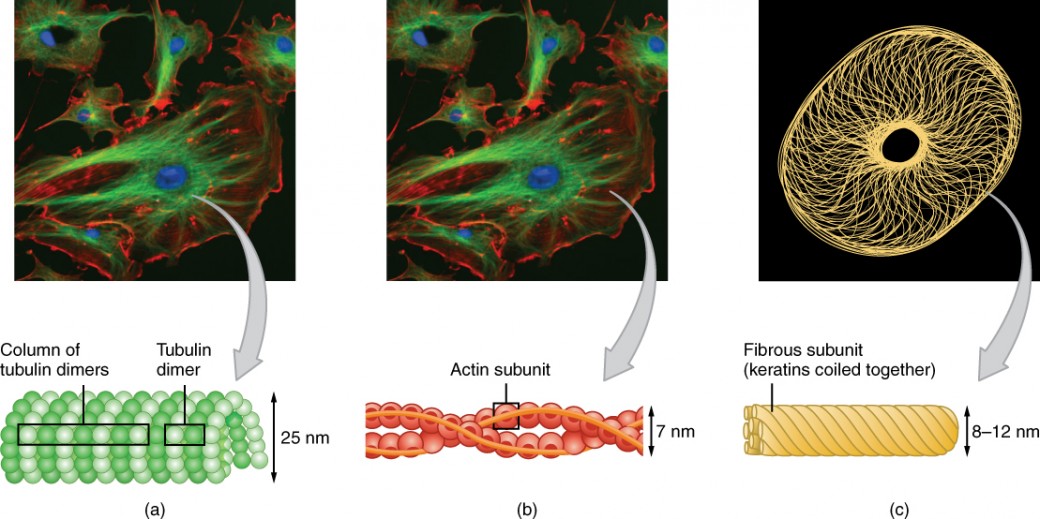
A very of import function of microtubules is to prepare the paths (somewhat like railroad tracks) along which the genetic material can be pulled (a process requiring ATP) during prison cell division, so that each new girl cell receives the appropriate set of chromosomes. Two short, identical microtubule structures called centrioles are found near the nucleus of cells. A centriole tin can serve as the cellular origin point for microtubules extending outward as cilia or flagella or tin assist with the separation of Dna during cell sectionalization by forming the mitotic spindle (spindle fibers).
Licenses and Attributions
Which Part Of The Cell Controls Movement In And Out Of The Nucleus,
Source: https://www.coursehero.com/study-guides/nemcc-ap/the-cytoplasm-and-cellular-organelles/
Posted by: tarterloyed1961.blogspot.com


0 Response to "Which Part Of The Cell Controls Movement In And Out Of The Nucleus"
Post a Comment